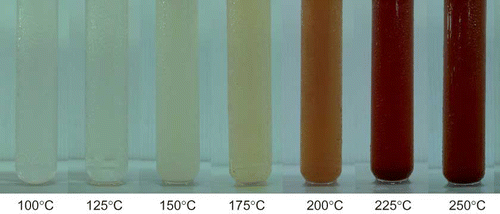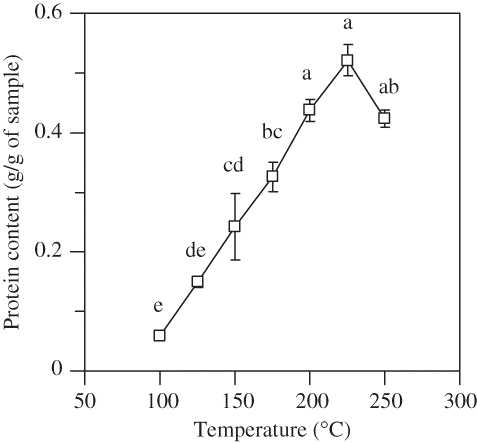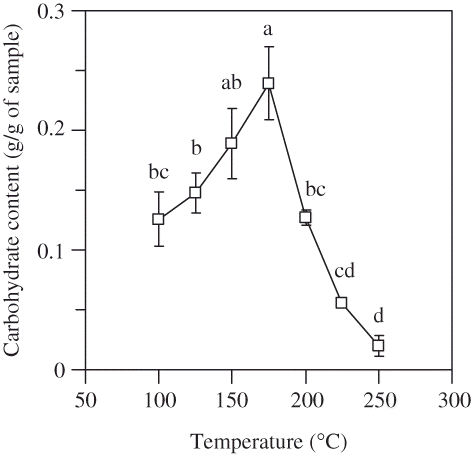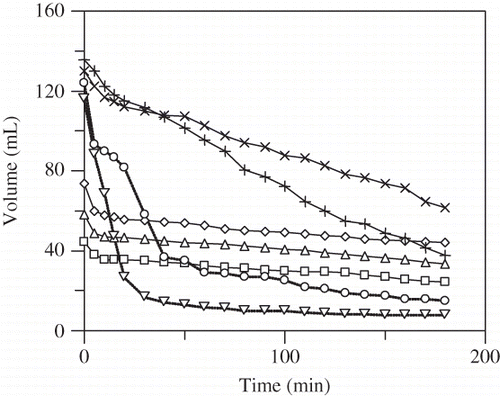Abstract
Soy meal from vegetable oil processing was treated with subcritical water at different temperatures (100, 125, 150, 175, 200, 225 and 250°C) for 5 min in a batch-type reactor. Maximum protein and carbohydrate contents in the liquid extracts were obtained at 225°C (0.52 ± 0.03 g/g of sample) and 175°C (0.24 ± 0.03 g/g of sample), respectively. The extracts from all treated temperatures similarly formed and stabilized oil-in-water type emulsion. However, the extracts at different temperatures showed different foaming capacities during 3 h of storage. Because of a short extraction time of the process, subcritical water treatment is a promising technology for producing functional substances from this industrial by-product.
INTRODUCTION
Subcritical water (superheated water or pressurized hot water) is generally defined as liquid water at temperature between 100°C (boiling point) and 374°C (critical point) under pressurized condition. Under these conditions, the ion product (i.e., hydronium ion and hydroxide ion concentration) of water increases several times and therefore promotes hydrolysis reaction of different groups of compounds in subcritical water.[Citation1–3 Several authors have reported the potential of using subcritical water for conversion of low-value bio-resources into higher-value compounds, for example, the conversion of fish and scallop wastes into amino acids and organic acids,[Citation4,Citation5] the conversion of spent yeast and rice bran into amino acids.[Citation6,Citation7] Some functional properties of hydrolyzed products obtained by subcritical water treatment have also been evaluated, for example emulsifying, foaming and antioxidative properties of rice bran extracts.[Citation8–10]
Soy meal from soybean oil extraction process contains high amount of protein and carbohydrate.[Citation11] It is a raw material for production of soy protein products, such as soy protein concentrate and soy protein isolate, which are used in various food industries and the production processes are well understood.[Citation11] Recently, researchers demonstrated that treatment of soy meal with subcritical water also yielded high amount of protein and sugar in the soluble product.[Citation12] However, functional properties of the extracts have not been reported in the literature. Since protein products are frequently determined for their emulsifying and foaming properties,[Citation13–15] therefore, these properties of the extracts obtained by subcritical water treatment at different temperatures were evaluated in this study.
MATERIALS AND METHODS
Materials
Soy meal, a residue from edible oil extraction process, was obtained from Thai Vegetable Oil PCL (Nakhon Pathom, Thailand). Moisture, protein and crude fat contents of the meal were analyzed using the oven drying method, Kjeldahl method and Soxhlet extraction method, respectively. The nitrogen-to-protein conversion factor was 6.25. Albumin from bovine serum (BSA), cupric sulfate and Folin-Ciocalteu phenol reagent were from Fluka (Switzerland). Boric acid and d-glucose were from Merck (Germany). Sodium carbonate, sodium dodecyl sulfate (SDS) and sodium sulphate were from Ajax Finechem (Australia). Sodium hydroxide and sodium tartrate were from Carlo Erba (France). Sulfuric acid was from Mallinckrodt (USA).
Subcritical Water Treatment
Treatment of the soy meal in subcritical water was done in a batch-type vessel. The vessel was fabricated from stainless steel with a total volume of 100 mL (Taiatsu Techno Corporation, Japan). A sample of soy meal (2.0 g) and distilled water (80.0 g), which has been purged with nitrogen gas to remove dissolved oxygen, were added into the vessel. The vessel was tightly closed and heated using a custom-made dry-block heater (Applied Scientific Instruments, Bangkok, Thailand) to specific temperatures (100–250°C). Heat up time need to reach all required temperatures was about 15 min. After heating at constant temperature for 5 min, the vessel was immediately cooled with water. The mixture was filtered through a filter paper (Whatman no. 1) and the filtrate was then centrifuged at 6,800× g for 15 min. The supernatant was collected and adjusted to 100 mL with distilled water for further analyses. Treatment at each temperature was done in duplicate.
Chemical Analyses
Soluble protein content in the extracts was determined using Lowry-Folin method.[Citation16] Bovine serum albumin (BSA) was used for preparing a protein standard curve. Total carbohydrate in the extracts was determined using phenol-sulfuric method.[Citation17] Glucose was used for preparing a carbohydrate standard curve. Each sample was evaluated at least in duplicate.
Emulsifying and Foaming Properties
Emulsifying properties of soy meal extracts were evaluated by turbidity measurement.[Citation18] A sample of the extract (7.5 mL) was emulsified with 2.5 mL of soy bean oil using a rotor-stator homogenizer (Ultra Turrax, IKA, Germany) at speed 2 (ca. 13,000 rpm) for 2 min. A freshly prepared emulsion sample (100 μL) was diluted with 10 mL of 0.1% sodium dodecyl sulfate (SDS) solution. An absorbance at 500 nm of the diluted sample was measured immediately (A 0) and 10 min (A 10) after preparation using a UV-vis spectrophotometer (GENESYS 20, Thermo Spectronic, USA). Turbidity (T), emulsifying activity index (EAI) and emulsion stability index (ESI) were defined as follows:
Statistical Analysis
To indicate the effect of treatment temperature on each response, one-way analysis of variance (ANOVA) was performed and Tukey's HSD method (α = 0.05) was used for multiple comparisons of means. All statistical analyses were performed using R statistical software version 2.5.1.[Citation20]
RESULTS AND DISCUSSION
Chemical Analyses of Soy Meal
Composition analyses showed that the raw material contained 10.44 ± 0.07 (% w/w) of moisture content, 49.42 ± 4.40 % (w/w) of crude protein and 2.90 ± 1.56 % (w/w) of crude fat. High protein content was in agreement with the value found in literature.[Citation11] Although this study did not analyze the carbohydrate content, the literature reported that soy meal contains about 30–32% carbohydrate.
Appearance of the Extracts
Photographs of soy meal extracts obtained at different treatment temperatures are shown in . Color of the extracts changed from colorless at 100 and 125°C to slight yellow at 150 and 175°C and finally to dark brown at 200–250°C. Dark brown color indicated a substantial degradation of protein and carbohydrate through the Maillard reaction, pyrolysis, and/or caramelization. Wiboonsirikul et al.[Citation8] have showed that hydrolyzate of rice bran obtained by subcritical water treatment at high temperature contains high amount of furfural which is an intermediate substance of browning reaction.
Change of Soluble Protein and Carbohydrate Contents
Since the main reaction occurs in the treatment of material with subcritical water is hydrolysis reaction, soluble protein and carbohydrate in the extract could be expected. Protein content in the extracts increased with temperature, reached the maximum at 225°C (0.52 ± 0.03 g/g of sample) and then the value fell abruptly at 250°C (). Similar pattern of protein content change was reported for extraction of rice bran.[Citation8] Tavakoli and Yoshida[Citation4] reported that highest yield of amino acid from hydrolysis of scallop viscera wastes was obtained at 240°C which is the temperature that the highest ion product of subcritical water attained. Carbohydrate content in the extracts also increased with temperature and reached the maximum at 175°C (0.24 ± 0.030 g/g of sample) but then decreased with temperature from 200 to 250°C (). Increasing of both protein and carbohydrate contents showed the potential of the extracts to be used as a functional ingredient.
Emulsifying and Foaming Properties
Soy protein can be used to form oil emulsion in various food products. Emulsifying properties are indicators for ability of formation and stabilization of emulsion. Turbidity (T) of fresh prepared emulsion and emulsifying activity index (EAI) are shown in . The extracts obtained at all temperatures tested possessed an emulsifying property. This might be explained from the amphiphilic character of soluble protein found in the extracts. Turbidities of fresh emulsions prepared from extracts at different temperatures were not different significantly. However, the EAI value, which took the amount of protein into account, showed that while the extract at higher temperatures contains more protein content, lower emulsion activity obtained. The highest EAI of the extract was obtained at 100°C was comparable to that of the soy protein hydrolysate obtained by enzymatic reaction,[Citation21] but only about one-third of that of conventional soy protein isolate (SPI) reported in literatures that using similar analytical method.[Citation21,Citation22] Emulsion stability index (ESI) of emulsions was only slightly increased as the extraction temperature increased (). Comparing with the ESI of SPI reported in Chove et al.[Citation22] (about 250 min), the ESI values of the extracts were quite low. Nevertheless, extraction time used for subcritical water treatment was very short comparing with conventional soy protein extraction. In addition, carbohydrate was present in the extract at high level and may adversely affect the emulsifying properties.
Figure 4 Emulsifying activity index (□) and turbidity (Δ) of the extracts prepared at various temperatures. Different letters indicate that the mean values significantly differ (Tukey's HSD, α = 0.05).
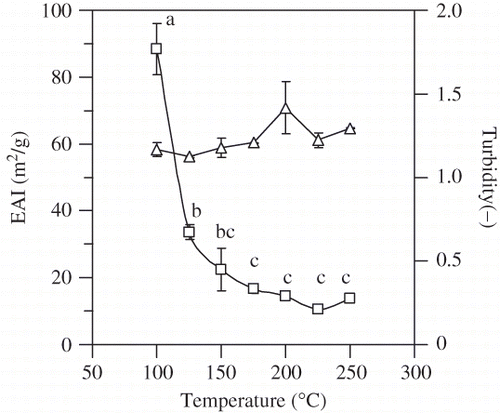
Figure 5 Emulsion stabilizing index of the extracts prepared at various temperatures. Different letters indicate that the mean values significantly differ (Tukey's HSD, α = 0.05).
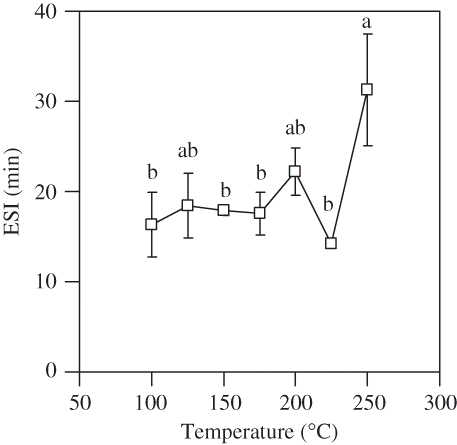
It is known that soy protein can form a film to entrap gas and used as a replacement for casein and egg white in bakery products.[Citation11] Foaming properties are indicators for ability of foam formation and stabilization. Foaming capacities of the extracts obtained at different temperatures () showed three different patterns. The extracts obtained at 100–150°C gave moderate volume (45–70 mL) of freshly prepared foams and the volume slightly decreased during first 5–10 min and then unchanged during 3 h of storage. The volume of foam was in the order of 150 > 125 > 100°C. The extracts obtained at 175 and 200°C show different pattern of foaming capability, their volumes at the beginning were high (130 mL) and the volumes almost linearly decreased with time. The extract at 200°C showed higher rate of decreasing than that of 175°C. The third pattern was from the extracts obtained at 225 and 250°C. Their volumes at the beginning were also high (120 mL), but the volumes rapidly decreased in 15–30 min and then quite constant until 3 h. The extract at the highest temperature (250°C) resulted in the least stable foam.
CONCLUSIONS
This study has showed that subcritical water treatment is a promising method to obtain products from soy meal that can be used to form and stabilize oil emulsion and foam. Different treatment temperatures gave different products that may be suitable for various applications. Moreover, this treatment may be applied as a protein modification to obtain products with different properties from conventional products.
ACKNOWLEDGEMENTS
This work was supported by a grant from Department of Food Technology, Faculty of Engineering and Industrial Technology, Silpakorn University.
REFERENCES
- Khuwijitjaru , P. , Fujii , T. , Adachi , S. , Kimura , Y. and Matsuno , R. 2004 . Kinetics on the hydrolysis of fatty acid esters in subcritical water . Chem. Eng. J. , 99 ( 1 ) : 1 – 4 .
- Haghighat Khajavi , S. , Kimura , Y. , Oomori , T. , Matsuno , R. and Adachi , S. 2005 . Kinetics on sucrose decomposition in subcritical water . LWT- Food Sci. Technol. , 38 ( 3 ) : 297 – 302 .
- Rogalinski , T. , Herrmann , S. and Brunner , G. 2005 . Production of amino acids from bovine serum albumin by continuous sub-critical water hydrolysis . J. Supercrit. Fluid , 36 ( 1 ) : 49 – 58 .
- Tavakoli , O. and Yoshida , H. 2006 . Conversion of scallop viscera wastes to valuable compounds using sub-critical water . Green Chem. , 8 ( 1 ) : 100 – 106 .
- Yoshida , H. , Terashima , M. and Takahashi , Y. 1999 . Production of organic acids and amino acids from fish meat by sub-critical water hydrolysis . Biotechnol. Prog. , 15 ( 6 ) : 1090 – 1094 .
- Sereewatthanawut , I. , Prapintip , S. , Watchiraruji , K. , Goto , M. , Sasaki , M. and Shotipruk , A. 2008 . Extraction of protein and amino acids from deoiled rice bran by subcritical water hydrolysis . Bioresour. Technol. , 99 ( 3 ) : 555 – 561 .
- Lamoolphak , W. , Goto , M. , Sasaki , M. , Suphantharika , M. , Muangnapoh , C. , Prommuag , C. and Shotipruk , A. 2006 . Hydrothermal decomposition of yeast cells for production of proteins and amino acids . J. Hazard. Mater. , 137 ( 3 ) : 1643 – 1648 .
- Wiboonsirikul , J. , Kimura , Y. , Kadota , M. , Morita , H. , Tsuno , T. and Adachi , S. 2007 . Properties of extracts from defatted rice bran by its subcritical water treatment . J. Agric. Food Chem. , 55 ( 21 ) : 8759 – 8765 .
- Wiboonsirikul , J. , Hata , S. , Tsuno , T. , Kimura , Y. and Adachi , S. 2007 . Production of functional substances from black rice bran by its treatment in subcritical water . LWT Food Sci. Technol. , 40 ( 10 ) : 1732 – 1740 .
- Khuwijitjaru , P. , Nualchan , P. and Adachi , S. 2007 . Foaming and emulsifying properties of rice bran extracts obtained by subcritical water treatment . Silpakorn U. Sci. &Tech. J. , 1 ( 1 ) : 7 – 12 .
- Hettiarachchy , N. and Kalapathy , U. 1997 . “ Soybean protein products ” . In Soybeans: Chemistry, Technology, and Utilization , Edited by: Liu , K. 379 – 411 . New York : Chapman & Hall .
- Watchararuji , K. , Goto , M. , Sasaki , M. and Shotipruk , A. 2008 . Value-added subcritical water hydrolysate from rice bran and soybean meal . Bioresour. Technol. , 99 ( 14 ) : 6207 – 6213 .
- Firebaugh , J.D. and Daubert , C.R. 2005 . Emulsifying and foaming properties of a derivatized whey protein ingredient . Int. J. Food Prop. , 8 ( 2 ) : 243 – 253 .
- Biasutti , E.A.R. , Vieira , C.R. , Capobiango , M. , Silva , V.D.M. and Silvestre , M.P.C. 2007 . Study of some functional properties of casein: Effect of pH and tryptic hydrolysis . Int. J. Food Prop. , 10 ( 1 ) : 173 – 183 .
- Wasswa , J. , Tang , J. and Gu , X. 2008 . Functional properties of Grass carp (Ctenopharyngodon Idella), Nile perch (Lates Niloticus) and Nile tilapia (Oreochromis Niloticus) skin hydrolysates . Int. J. Food Prop. , 11 ( 2 ) : 339 – 350 .
- Lowry , O.H. , Rosebrough , N.J. , Farr , A.L. and Randall , R.J. 1951 . Protein measurement with Folin phenol reagent . J. Biol. Chem. , 193 ( 1 ) : 265 – 275 .
- DuBois , M. , Gilles , K.A. , Hamilton , J.K. , Rebers , P.A. and Smith , F. 1956 . Colorimetric method for determination of sugars and related substances . Anal. Chem. , 28 ( 3 ) : 350 – 356 .
- Pearce , K.N. and Kinsella , J.E. 1978 . Emulsifying properties of proteins: evaluation of a turbidimetric technique . J. Agric. Food Chem. , 26 ( 3 ) : 716 – 723 .
- Makri , E.A. and Doxastakis , G.I. 2006 . Emulsifying and foaming properties of Phaseolus vulgaris and coccineus proteins . Food Chem. , 98 ( 3 ) : 558 – 568 .
- R Development Core Team. R: A language and environment for statistical computing. R Foundation for Statistical Computing: Vienna, Austria. 2007 http://www.R-project.org (http://www.R-project.org)
- Tsumura , K. , Saito , T. , Tsuge , K. , Ashida , H. , Kugimiya , W. and Inouye , K. 2005 . Functional properties of soy protein hydrolysates obtained by selective proteolysis . LWT - Food Sci. Technol. , 38 ( 3 ) : 255 – 261 .
- Chove , B.E. , Grandison , A.S. and Lewis , M.J. 2007 . Some functional properties of fractionated soy protein isolates obtained by microfiltration . Food Hydrocolloid , 21 ( 8 ) : 1379 – 1388 .
